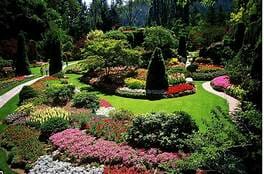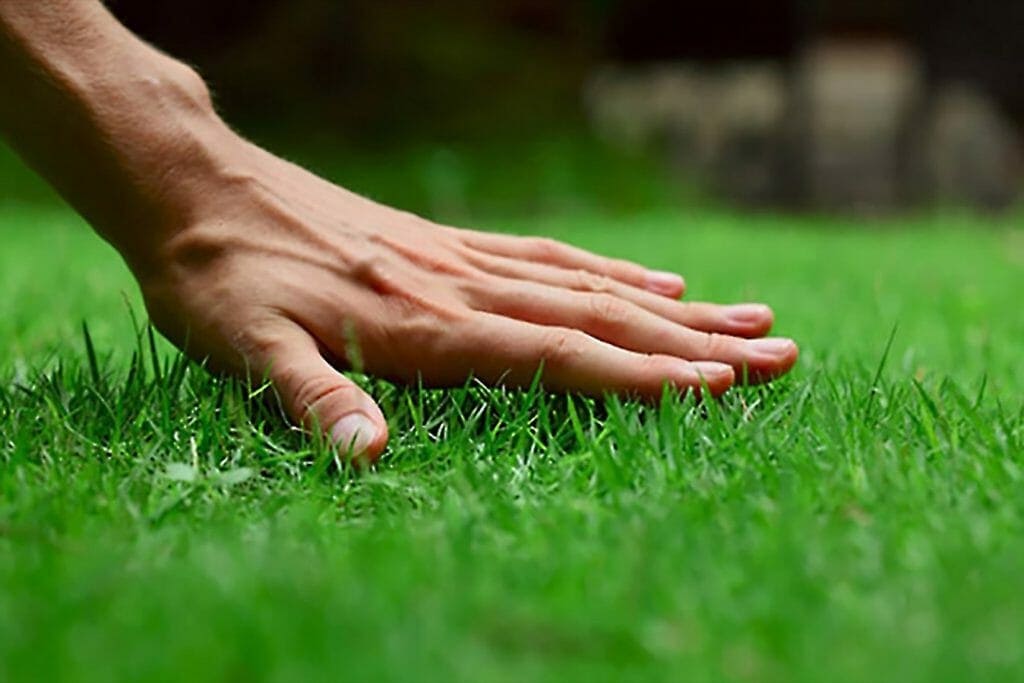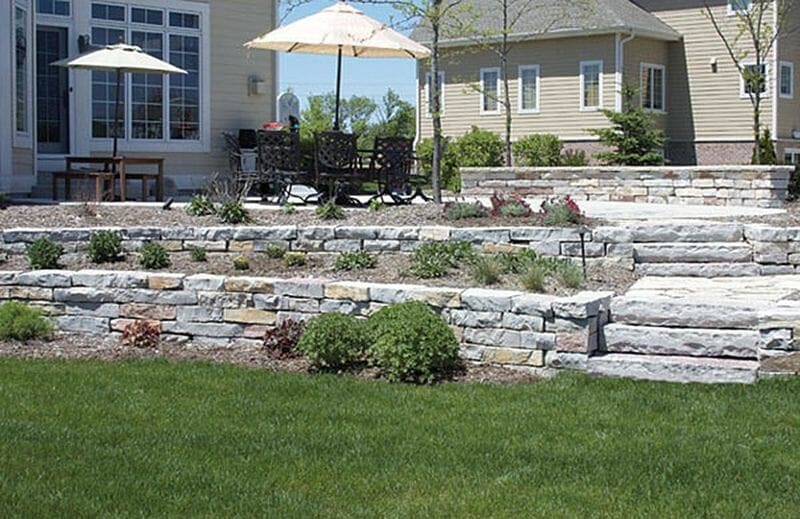Written by VICTORIA LEE BLACKSTONE and published on https://www.hunker.com/
Are you looking for the basic principles of landscape design? Whether you’re planning to “borrow ideas,” or coming up with your customized landscape design, you need to know the basic principles of landscape design. Understanding these landscape design principles will increase your creativity while at the same time helping you generate new ideas. A great landscape design lies in the eyes of the artist, and these basic principles of landscape design will not only boost your creativity but also ensure that the elements in your design have balance and harmony.
The Principles of Landscape Design
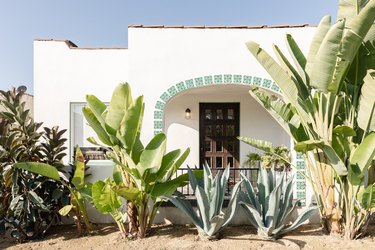
Although a landscape design ultimately relies on personal preference for its subjective merits, following some basic design principles can make the difference between a cohesive look and a disjointed one. Although plants play a significant role in the landscape, their selection comprises only one of many design elements.
By following some basic principles of landscape design, you needn’t relinquish your personal style in favor of a cookie-cutter look that’s often replicated in many subdivisions — you can leave that to your neighbors.
Six Basic Landscape Design Principles
As Michigan State University Extension notes, landscape design shares common ground with other art forms, including other applied arts as well as the fine arts, through six basic principles of design. Within these six categories are additional elements that more fully flesh out the broader principles.
- Simplicity
- Focalization
- Balance
- Proportion/scale
- Rhythm and line
- Unity
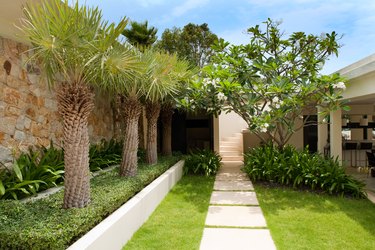
Simplicity Principle in Landscape Design
Achieving simplicity in the landscape doesn’t mean you have to work toward a sparse look with only a few plants dotted about, nor do you have to omit other features, such as hardscapes and lighting effects. Many landscape designs are quite complex, but their simplicity lies in their avoidance of clutter and their repetition of certain plants, shapes, textures and colors. Even a casual garden, such as a cottage garden that may hold a lot of plants in a small space, can still achieve simplicity by its adherence to a complementary color scheme instead of a free-for-all mishmash.
Focalization Principle in Landscape Design
When you look at a landscape, the first thing that “pops” by drawing your eye to it is the focal point, fulfilling the landscape design principle of focalization. A garden design may have more than one focal point, but it typically has one primary focal point.
Secondary focal points, which do not compete with the primary focal point for attention by creating confusion and causing viewer discomfort, may enhance an overall landscape design. Two primary focal points in the same landscape are not competitors, however, when one is in the front yard and another one is in the backyard.
Focal points include different features and structures such as plants, garden structures, hardscapes and aquascapes. Even elements such as texture, movement and color can serve as focal points. Geometric shapes, such as lines and circles that are formed by certain design components, also contribute to focalization. For example, the straight or curved line of a sidewalk or garden path can be used to direct attention to a featured plant or a structure such as a pergola.
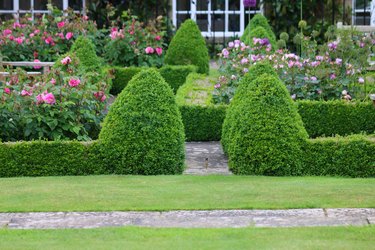
Balance Principle in Landscape Design
Balance in a landscape design offers a pleasing sight and a comfortable experience for the viewer. On the flip side, Dr. Ellen Vincent of Clemson University notes that an unbalanced landscape can actually cause the viewer to become uncomfortable.
Achieving balance means that you have equal visual weight on both sides of a landscape, but it doesn’t mean that you must have exactly the same number and types of plants, garden structures or colors on each side of your yard. This arrangement, however, does describe one of the three types of balance in a landscape design: symmetrical balance.
Symmetrical balance. Most often used in formal landscape designs, symmetrical balance creates a reflection of one side of the design onto the other side. In other words, if you drew an imaginary line down the center of a landscape design, each side divided by the line is a mirror image of the other side. Typically, symmetrically balanced landscapes require high maintenance to keep their symmetry. Picture a formal courtyard garden with perfectly trimmed hedges that form borders around quadrants containing identical perennial plants.
Asymmetrical balance. Most often used in informal landscape designs, asymmetrical balance has the same visual weight on both sides of a central axis, but the design elements are not mirror images of each other. Asymmetrical landscape designs appear more relaxed and not as “buttoned up” as symmetrical designs. Groupings, combinations or clusters of plants and structures can create asymmetry in the landscape while still achieving balance.
Proximal/distal balance. Also called perspective balance, this type of design emphasizes the relationships between near and far landscape components; it addresses the view of the foreground, midground and background of a design. So, for example, objects in the foreground that are closer to the viewer have greater visual weight even though they’re generally smaller than, for example, tall trees in the background.
Proportion/Scale Principle in Landscape Design
Landscape design includes two facets of proportion. While relative proportion considers the size of an object in comparison to other objects in the landscape, absolute proportion considers only the size of one specific object. The human scale, which represents the size of the human body, is one example of absolute proportion. When comparing the human scale to plant scale, house scale and garden structures scale, it’s this proportionate size relationship that helps landscape designers produce comfortable, workable and functional designs.
As one example, an oversized patio that overwhelms the scale of a home looks disproportionate and throws the total design out of balance. A small plant in a large urn, particularly if the container planting is meant to be a focal point, falls far short of its intended impact because the relative proportion is off kilter.
Proportion doesn’t only consider tangible items; it also considers open space. Not every nook and cranny in a landscape needs to contain plants, structures or other garden features. Open spaces provide not only balance but also proportion in design as well as a reprieve from an otherwise busy landscape.
Rhythm and Line Principle in Landscape Design
Just as the rhythmic cadence of a drum beat adds repetition to a musical score’s theme, rhythm in the landscape repeats the elements of a design. Landscape rhythm is separated by standard intervals, most commonly represented as space. In other words, the rhythm may consist of plant groupings and the space between the groupings. Even separate sitting areas with space between each area provide landscape rhythm.
Landscape lines are formed by forms and shapes of garden beds, sidewalks, patios, plants and even the home itself. Worthy of note is that the lines of a landscape aren’t always straight. Curvilinear lines help soften the harshness that too many straight lines create, and they can also gently assist the viewer by offering a gradual change of flow in design as the overall theme transitions from one area to the next.
Also, landscape lines don’t always follow a route along the ground. Vertical lines add another dimension to the horizontal lines that exist on the ground plane, which is the landscape floor. Trees, walls and fences are some of the landscape components that create vertical lines. These vertical lines form outdoor walls, enclose garden spaces and create backdrops for a landscape design.
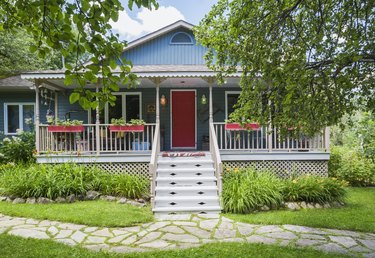
Unity Principle in Landscape Design
When a landscape design achieves unity, the aforementioned principles and the contributing components that support these principles harmoniously work together as a single unit. The overall design is not awkward or cumbersome, and it doesn’t leave the viewer with tired eyes.
You’ll know when you have a unified landscape design, according to North Carolina State Extension, because it looks good when viewed from every angle. The design forms a seamless integration of components that complement each other instead of competing for attention. You’ll also know that you’ve achieved design success when your landscape provides picture-worthy views as you enjoy the design from inside your home when looking out of the windows.
Contributing Components to Design Principles
While principles are standards that influence landscape designs, individual components that support these principles may fall under more than one principle. For example, color in landscape design is a component that may influence numerous principles, such as focalization, balance and unity. Likewise, plant choices may also influence numerous principles, such as simplicity, proportion and rhythm. An effective landscape design considers not only the six basic principles but also the component subsets that populate these principles.
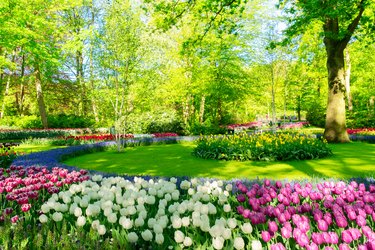
Color in Landscape Design
Landscape design color schemes are largely based on personal preference. Some gardeners lean toward a palette of cool colors, while other gardeners prefer warm colors. There’s also the choice of bright colors or subdued colors, making the color scheme even more subjective. Mississippi State University Extension suggests that color is the most challenging component in a landscape design.
As important as color choice is, as a rule of thumb, it is one of the last components that landscape designers put into place. It’s similar to an artist who makes a sketch of her subject before adding color. She may draw an outline, embellish the picture with a focal point, fine-tune the sketch by adding background balance and make sure that everything is in proportion all before she picks up a paintbrush to add color.
Landscape designers and other artists commonly use the color wheel. University of Florida IFAS Extension explains this color wheel by separating its arrangement of colors into three primary colors (red, yellow and blue), three secondary colors (orange, green and purple) and six tertiary colors. Color theory defines the relationship of these colors on the color wheel and helps designers choose a color scheme that’s complementary, with choices that exist on opposite sides of the color wheel, such as red and green.
When choosing colors for a landscape design, the color of a home or the color of another structure, garden ornaments and hardscapes add to the overall color scheme. It’s not just flowers that add color from plants to a landscape — foliage, fruit, berries and even bark can also add brushstrokes of color.
Plants in Landscape Design
Plant selection covers a lot of territory in landscape design. Not only are individual plants a consideration but also the climate, soil, elevation, light conditions and other factors that will support growth for different types of plant material. Your local cooperative extension service is a valuable resource for recommending suitable plants for the region where you live.
Large trees, small trees, shrubs, perennials, vines and ground covers are just some of the plant types to consider. Plant forms also cover a lot of territory, with shapes ranging from rounded, columnar, upright, cascading and vase-shaped. These and other architectural design elements found in different types of plants contribute interest to a well-appointed landscape.
Garden Structures in Landscape Design
Arbors, pergolas and trellises are some examples of garden structures that boost design appeal while supporting vines. Although these terms are sometimes used interchangeably, University of Florida IFAS Extension makes a distinction between their forms and functions.
An arbor may be either a partially enclosed or recessed area that’s shaded by trees, but a garden arbor also refers to a structure that supports vines over its latticework with a bench underneath. A trellis is essentially an arbor without the bench, although other types of trellises are flat structures attached to walls or used as freestanding structures against walls. A pergola is a long trellis structure over a walkway, typically covered with vines.

Hardscapes and Aquascapes
Effective use of hardscapes can complement the plant material in a landscape. Driveways, sidewalks, patios, decks, benches and stone walls add texture to a landscape design and define borders, boundaries and recreation areas. As with any landscape design element, the overuse of hardscapes interrupts the flow of a design. If, for example, you have a swimming pool with a concrete surround, additional concrete structures can overwhelm a small landscape.
Another way to enjoy a visually and aurally appealing feature in your landscape design is to add a water feature. Water walls, pondless waterfalls and fountains are some examples of aquascapes that function as strong focal points. Whether you have a small water feature, such as a tabletop recirculating fountain, or a large aquascape, such as a koi pond, the look and sound of water can enhance any landscape.
Putting It All Together
Between the actual principles of landscape design and all the components that make these principles work, designing your own plan can be a daunting task. Instead of tackling a grand master plan for your entire landscape by yourself, calling on professional landscape designers and landscape architects may be a step in the right direction.
You can contract some designers to only make recommendations without an actual diagrammed plan or drawings so that you can do the actual work yourself while others may offer a design plan, which includes recommended plant selections and proper placement of plant materials as well as garden structures. Many landscape designers will do all the work for you — drawing up plans, choosing plants and other materials and installing their design.
Original post here https://www.hunker.com/13727251/the-principles-of-landsacpe-design

